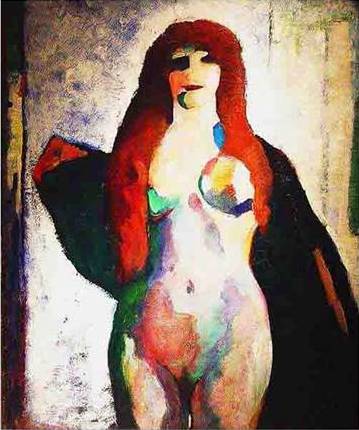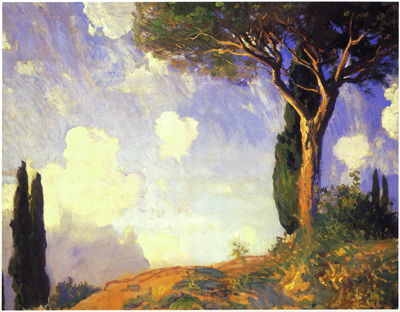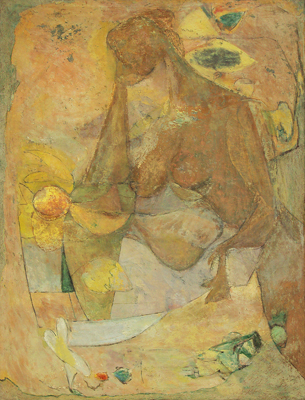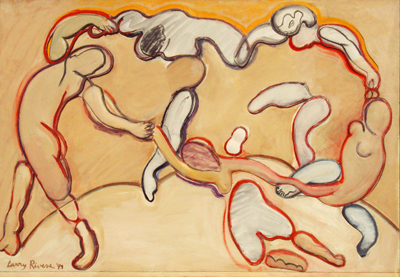"MODERNIST COLOR: THE FIRST 90 YEARS" at Vered Gallery
September 5 - October 30, 2014
Gallery Talk: Sundays in September from 4 to 6 p.m. Refreshments served.
Vered Gallery is located at 68 Park Place, East Hampton, NY 11937 in the Starbucks passageway. www.veredart.com 631-324-3303
Vered Gallery presents "Modernist Color: The First 90 Years" from August 29 through October 30, 2014. Highlights include paintings by John Singer Sargent, Arthur B. Carles, Russell Morgan, John Sloan, Arthur Dove, Milton Avery, Arshile Gorky, Larry Rivers and Helen Frankenthaler. Photography highlights are works by Alvin Langdon Coburn, F. Holland Day and Robert Mapplethorpe.
Willem de Kooning, in a conversation with Robert Rauschenberg, once described art history as being like a bowl of alphabet soup: "You stick your hand in it and find something for yourself." "Modernist Color: The First 90 Years" is bound to have viewers living de Kooning's words.
.

"Standing Nude" by Arthur B. Carles, 1912. Oil on canvas, 39 7/8 by 31 1/2 inches. Courtesy Vered Gallery.
.
Modernism was the successor to Classical painting. The 'Old Masters' regarded the physical limitations of painting as wholly negative. They invented perspective space to conceal the flat surface of the canvas and used layers of underpaint to subtly helping to create form. With the advent of photography in 1839, painters felt the need to recalibrate; to seek a means of expression beyond the concept underlying classical painting and to move beyond the limitations of the camera, which had begun to erode their 'business'.
The painter Paul de la Roche in 1839, perfectly expressed his shock in the 'new' upon seeing the first photograph, a daguerreotype, by saying, "From today, painting is dead."
The 'limitations' perceived by Classical painters were embraced by modernist practice as openly positive identifiers of Modernism. As such, flatness, literal shape and color became primary and representative of the 'pure' qualities of the emerging modernist aesthetic. The Modernists withdrew from representing reality in favor of an increasing preoccupation with the problems intrinsic to painting itself. Issues of color and form became a main focuses of the Modernist.
"Modernist Color" opens the Modernist period with Landscape Study at San Viglio, Lake of Garda, 1913, by John Singer Sargent. The painting comes as an exquisite surprise. It is similar in its translucent sense to the expression of Singer Sargent's watercolors from the Boston Museum of Fine Arts and Brooklyn Museum collections and exhibited last year at the Brooklyn Museum in "John Singer Sargent Watercolors".
.

"A Landscape Study at San Viglio, Lake of Garda" by John Singer Sargent, 1913. Oil on canvas, 35 x 45 inches. Courtesy Vered Gallery.
.
Early Modern works exhibited in "Modernist Color" continue with Morgan Russell's Portrait of Paul Cezanne 1913, and Arthur B Carles' full blown modernist work, Nude Torso 1913. The early period is also represented by precisionistic abstractions by Arthur Dove and Joseph Stella, both from 1920, and Oscar Bluemner's quintessential Sunrise, 1925, a watercolor dayscape of Elizabeth, N.J.
The middle period of Modernism is represented with Milton Avery's Coney Island 1931, a prescient work which establishes Avery's particular use of color and form, characteristics which mark Avery's long career; a career finally reaching into the abstraction of subject almost entirely. However Avery, like Helen Frankenthaler, never chose to fully abandon subject matter in their art.
Arshile Gorky's Mother and Child, 1937, is an amazing synthesis of Cubism. It is one of the best examples of Gorky's technique of sanding the painting's surface to increase the sense of depth. Gorky pioneered this new method, which was adopted, among others, by Willem de Kooning.
.

"Maternity" by Arshile Gorky, 1937. Oil on canvas, 40 x 32 inches. Courtesy Vered Gallery.
.
A second significant work of this middle period is Larry Rivers', Portrait of Berdie, 1952. Rivers paintings of 'Berdie' are largely held by museum collections, including the Whitney Museum of American Art, the Metropolitan Museum of Art and Rhode Island School of Design Museum.
River's art also represents that later part of Modernism with Le Dance (Ochre), 1993. The painting pays respect to Matisse's la Danse, 1909, and the line and color of de Kooning's final paintings in the 1980s, that were so much disparaged by the 'cognoscenti' of the time. Le Dance (Ochre) is an exciting moment in a career of prescient painting by Rivers. Rivers is referred to by art scholars as the "Godfather" and "Grandfather" of Pop Art because he was one of the first artists to really merge non-objective, non-narrative art with narrative and objective abstraction.
.

"Le Dance (Ochre)" by Larry Rivers, 1993. Oil and board on canvas, 47 x 68 x 3 inches. Courtesy Vered Gallery.
.
The later period of 'contemporary' Modernism is also represented by Helen Frankenthaler's Quattrocento, 1984, which is ever so respectful of the debt owed to Arthur B. Carles and Rivers. Experimentation led Frankenthaler to create the heroic, large-scale work. All will agree that without the A. B. Carles' synchronist Nude Torso, Frankenthaler's Quattrocento would not have come into being.
Pivotal photographs by modernist progeniteur photographers Alvin Langdon Coburn and F Holland Day, along with the iconoclastic modernist photographer Man Ray and the brilliant colorist, photographer Robert Mapplethorpe, contribute important context and noteworthy works to "Modernist Color".
"Modernist Color: The First 90 Years" is curated by gallery owner Janet Lehr, who has worked extensively with the Library of Congress, The Cleveland Museum, Detroit Art Institute, National Gallery Australia, The Getty Museum, The Amon Carter Museum, The Bibliotheque Nationale, Paris, in building their permanent photography collections.
BASIC FACTS: "Modernist Color: The First 90 Years" remains on view through October 30, 2014. A Gallery Talk, led by curator and gallerist Janet Lehr, takes place every Sunday in September from 4 to 6 p.m. Vered Gallery is located at 68 Park Place, East Hampton, NY 11937. www.veredart.com. The gallery is open daily from 11 a.m. to 6 p.m. and on Saturdays until 9 p.m.
_______________________________
Copyright 2014 Hamptons Art Hub LLC. All rights reserved.
